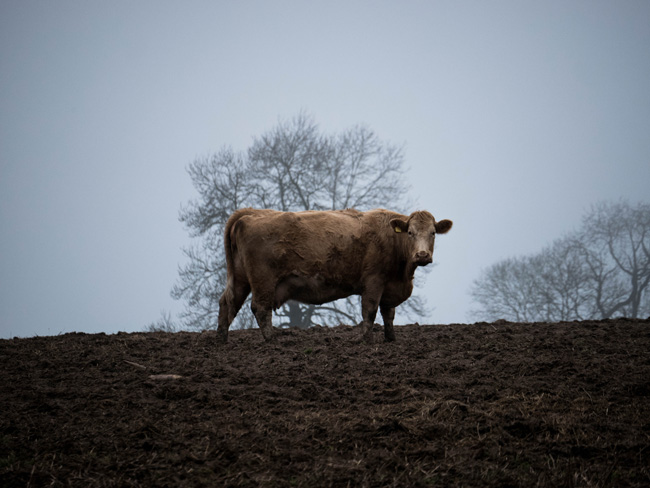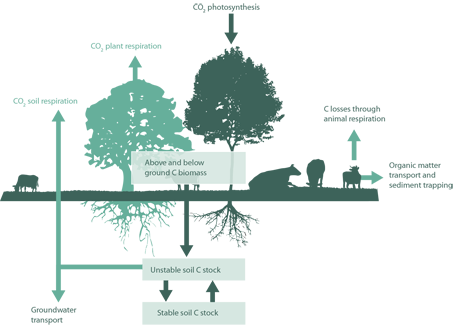Livestock can under certain conditions and for limited periods of time contribute to carbon sequestration in grasslands, but this can at best offset no more than 11 per cent of all livestock emissions.
Ruminants (cattle, buffalo, sheep and goats), have in recent decades gained a bad reputation as an environmental culprit and been blamed for climate change, deforestation and biodiversity loss, as well as the pollution of soils, air and water. But there is also a counter argument. Not all beef is bad they say, claiming that well-managed grazing systems allow ruminants to sequester carbon in grasslands, such that this sequestration partially or entirely compensates for the carbon dioxide, methane and nitrous oxide these systems generate.
The report “Grazed and confused” by the Food and Climate Research Network is a thorough analysis that aimed to find out if there is any truth behind that claim. Though it might be possible under special circumstances and for a limited period of time, the general the answer the authors give is no.
There are only a few peer-reviewed studies that have made global estimations of the biophysical sequestration potential of grasslands. The most optimistic study says that the potential can reach 800 Mt CO2-eq a year, and the most pessimistic one only 295 Mt CO2-eq a year. This can be compared to current annual emissions from grazing ruminants that are estimated at about 1.32 Gt CO2-eq (a figure that includes supply chain and land use change-related impacts). It can also be compared to the 7.1 Gt CO2-eq a year caused by the entire livestock chain and 49 Gt CO2-eq, which is an estimate of all anthropogenic emissions. In other words, the potential for offsets is 20–60 per cent of emissions from grazing systems: 4–11 per cent of total livestock emissions, and between 0.6 and 1.6 per cent of total annual greenhouse gas emissions
It is important to note that the sequestration potential is very context-specific. In some places and over a limited period of time sequestration can be quite high. This is often true for degraded soil, since there is more room for improving management practices and “restoring” the carbon stock, but low rainfall levels may be a limiting factor, and the economic and logistical obstacles will often be greater. However, the reverse can also happen, a lot of carbon will be lost when grasslands are exposed to drought or overgrazing.
Another fact to be aware of is that some management practices that will promote carbon sequestration, such as fertilisation, irrigation and introducing new grass species, can have other environmental implications.
The exact number of animals that feed entirely on grass is not known but it is likely to be very low and their contribution to overall animal protein will be even lower. As to the grasslands that the animals graze, these are among the largest ecosystems in the world, occupying between 20 and 47 per cent of the land area. Only a smaller part of this is natural and semi-natural grasslands, which host most of the biodiversity. Most is improved grasslands and pastures. And most of it would turn to forest if left unmanaged.
There is some evidence that grasslands can store more carbon than forests. But in most regions forests are better than grasslands at storing carbon. Boreal forests are the ecosystems with the greatest per hectare capacity, only outperformed by wetlands. Meaning that from a narrow climate perspective the best approach would be to grow food on as small an area as possible and afforest all remaining land.
Another aspect is that grass-fed ruminants only contribute to a fraction of all meat and milk. The animals that are only fed on grass contribute just one gram of protein per person per day. Though there are also animals in mixed agricultural systems, often a greater part of their feed comes from other sources. It is hard to put a figure on this, but some of the protein produced in those systems should also be attributed to grass. Nevertheless, it is reasonable to assume that ruminants feeding on grasslands only make a minor contribution to global human nutrition. The entire animal livestock sector contributes to 27 grams of protein per person per day and most protein in human diets comes from plant sources. There are naturally local exceptions, especially for people living on marginal lands for whom grazing livestock can be a vital source of nutrition.
Another common argument in support of grass-fed livestock is that their methane emissions are “natural”, since they have been preceded by wild ruminants in historic and prehistoric times. In one study, it was found that during the late Pleistocene, 12–13,000 years ago, the emissions of the existing megafauna were virtually equivalent to those of farmed animals today. When they died out and forests spread over the northern hemisphere this caused a cooling effect on the climate. Smaller cooling effects have been observed following the mass bison slaughter and after the greatest outbreak of African Rinderpest, both in the 1800s. The authors note that although the notion of some kind of prehistoric ecological baseline might be interesting, “its relevance to the challenges we face today is negligible”. A more important conclusion from these studies is that the number of ruminants has a significant effect on our climate.
The report also discusses whether the other two greenhouse gases emitted by the livestock sector, methane and nitrous oxide, should be seen as more important or less important greenhouse gases. On the one hand, they are more potent per tonne than carbon dioxide, but on the other hand they are less stable and have a shorter lifetime in the atmosphere. That means that measures to reduce methane and nitrous oxide can have quite a big effect in the short term. But if these measures are taken instead of reducing carbon dioxide emissions the effects will be worse in the long run. The sound conclusion reached by the authors is that we are not really in a position where we can pick and choose. More or less all means available should be used to combat climate change.
Kajsa Pira
The report “Grazed and confused” by the Food and Climate Research Network: http://www.fcrn.org.uk/projects/grazed-and-confused
|
Carbon sequestration – how does it work?
Land-based ecosystems can be a sink of carbon when the pace of CO2 fixation through photosynthesis exceeds respiration and organic matter oxidation. However, if the opposite happens the process will be reversed and the ecosystem will be a source of carbon dioxide. Any carbon sequestrated can easily return to the atmosphere, if land is overgrazed, trees felled, biomass burned, or carbon-rich peat soils are drained or ploughed up. Another important aspect of carbon sequestration is that the process will reach equilibrium after a while. This happens when the amount of carbon sequestrated equals the amount released through different degradation processes. The equilibrium is different for different ecosystems and if the land use is changed it may take some years, decades or even a century before a new equilibrium is reached. There is a risk of presenting unrealistic figures when the high levels of carbon sequestration that can sometimes be observed when a baseline condition for an ecosystem is altered are extrapolated as a general figure for all similar ecosystems over a long period of time.
|

































